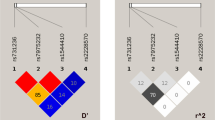Abstract
Myasthenia gravis (MG) is a sporadic disorder that has been increasingly linked to inherited genetic factors. Previous studies have demonstrated that human leukocyte antigen (HLA) plays an important role in the pathogenesis of MG. We determined the genotypes of the HLA-A, B, and DRB1 alleles in 257 southern Chinese Han MG patients using polymerase chain reaction sequence-based typing (PCR-SBT). The allele frequencies in the MG patients were compared to 292 healthy controls using the case–control method. HLA-A*0207, HLA-B*4601, HLA-DRB1*0403, HLA-DRB1*0901, and HLA-DRB1*1602 were more frequent in juvenile ocular MG patients than controls. HLA-DRB1*0701 was significantly reduced in the juvenile ocular MG group compared with controls. HLA-A*0207-B*4601, HLA-B*4601-DRB1*0403, HLA-B*4601-DRB1*0901, and HLA-B*4601-DRB1*1602 were found to be in strong linkage disequilibrium in juvenile ocular MG patients. Within the MG patients, there was a strong positive association between HLA-B*4601-DRB1*0901 and juvenile ocular MG patients, and the value of odds ratios (OR) decreased as the disease became more severe and the age of onset increased. We believe this could be the main heredity phenotype in juvenile ocular MG patients from southern China and may be a clinical marker to predict the severity of the disease.
Similar content being viewed by others
References
Kerty E, Elsais A, Argov Z et al (2014) EFNS/ENS guidelines for the treatment of ocular myasthenia. Eur J Neurol 21(5):687–693
Berrih-Aknin S, Frenkian-Cuvelier M, Eymard B (2014) Diagnostic and clinical classification of autoimmune myasthenia gravis. J Autoimmun 48–49:143–148
Gilhus NE (2009) Autoimmune myasthenia gravis. Expert Rev Neurother 9(3):351–358
Li F, Szobor A, Croxen R et al (2001) Dominantly inherited familial myasthenia gravis as a separate genetic entity without involvement of defined candidate gene loci. Int J Mol Med 7(3):289–294
Lee BW, Ihm SH, Shin HS et al (2008) Malignant thymoma associated with myasthenia gravis, Graves’ disease, and SIADH. Inter Med 47(11):1009–1012
Murai H (2014) Myasthenia gravis: past, present and future. Rinsho Shinkeigaku 54(12):947–949
Feng HY, Liu WB, Luo CM et al (2012) A retrospective review of 15 patients with familial myasthenia gravis over a period of 25 years. Neurol Sci 33(4):771–777
Saint-Faust M, Perelman S, Dupont D et al (2010) Transient neonatal myasthenia gravis revealing a myasthenia gravis and a systemic lupus erythematosus in the mother: case report and review of the literature. Am J Perinatol 27(2):107–110
Kerzin-Storrar L, Metcalfe RA, Dyer PA et al (1988) Genetic factors in myasthenia gravis: a family study. Neurology 38(1):38–42
Provenzano C, Arancio O, Evoli A et al (1988) Familial autoimmune myasthenia gravis with different pathogenetic antibodies. J Neurol Neurosurg Psychiatry 51(9):1228–1230
Huang X, Liu WB, Men LN et al (2013) Clinical features of myasthenia gravis in southern China: retrospective review of 2154 cases over 22 years. Neurol Sci 34(6):911–917
Deitiker PR, Oshima M, Smith RG et al (2011) Association with HLA DQ of early onset myasthenia gravis in Southeast Texas region of the United States. Int J Immunogenet 38(1):55–62
van Lith M, McEwen-Smith RM, Benham AM (2010) HLA-DP, HLA-DQ, and HLA-DR have different requirements for invariant chain and HLA-DM. J Biol Chem 285(52):40800–40808
Iwasa K, Kato-Motozaki Y, Furukawa Y et al (2010) Up-regulation of MHC class I and class II in the skeletal muscles of myasthenia gravis. J Neuroimmunol 225(1–2):171–174
Xie YC, Qu Y, Sun L et al (2011) Association between HLA-DRB1 and myasthenia gravis in a northern Han Chinese population. J Clin Neurosci 18(11):1524–1527
Nikolic AV, Andric ZP, Simonovic RB et al (2015) High frequency of DQB1*05 and absolute absence of DRB1*13 in muscle-specific tyrosine kinase positive myasthenia gravis. Eur J Neurol 22(1):59–63
Bartoccioni E, Scuderi F, Augugliaro A et al (2009) HLA class II allele analysis in MuSK-positive myasthenia gravis suggests a role for DQ5. Neurology 72(2):195–197
Deitiker PR, Oshima M, Smith RG et al (2006) Subtle differences in HLA DQ haplotype-associated presentation of AChR alpha-chain peptides may suffice to mediate myasthenia gravis. Autoimmunity 39(4):277–288
Alahgholi-Hajibehzad M, Yilmaz V, Gülsen-Parman Y et al (2013) Association of HLA-DRB1*14, -DRB1*16 and -DQB1*05 with MuSK-myasthenia gravis in patients from Turkey. Hum Immunol 74(12):1633–1635
Niks EH, Kuks JB, Roep BO et al (2006) Strong association of MuSK antibody-positive myasthenia gravis and HLA-DR14-DQ5. Neurology 66(11):1772–1774
Marino M, Maiuri MT, Di Sante G et al (2014) T cell repertoire in DQ5-positive MuSK-positive myasthenia gravis patients. J Autoimmun 52:113–121
Yousefipour GA, Salami Z, Farjadian S (2009) Association of HLA-DQA1*0101/2 and DQB1*0502 with myasthenia gravis in southern Iranian patients. Iran J Immunol 6(2):99–102
Jaretzki A 3rd, Barohn RB, Ernstoff RM et al (2000) Myasthenia gravis. Recommendations for clinical research standards. Task Force of the Medical Scientific Advisory Board of the Myasthenia Gravis Foundation of America. Neurology 55(1):16–23
Stojkovic T, Behin A (2010) Ocular myasthenia: diagnosis and treatment. Rev Neurol 166(12):987–997
Zach H, Cetin H, Hilger E et al (2013) The effect of early prednisolone treatment on generalization. Eur J Neurol 20(4):708–713
Angelini C (2011) Diagnosis and management of autoimmune myasthenia gravis. Clin Drug Investig 3(1):1–14
Hellmann MA, Mosberg-Galili R, Steiner I (2013) Myasthenia gravis in the elderly. J Neurol Sci 325(1–2):1–5
Segawa M (1973) Myasthenia gravis—latent general type. Naika 31:1222–1226
Shinomiya N, Nomura Y, Segawab M (2004) A variant of childhood-onset myasthenia gravis: HLA typing and clinical characteristics in Japan. Clin Immunol 110(2):154–158
Cheng C, Liu Z, Xu F et al (2013) Clinical outcome of juvenile myasthenia gravis after extended transsternal thymectomy in a Chinese cohort. Ann Thorac Surg 95(3):1035–1041
Wang H, Su Z, Luo C et al (2013) The effect of steroid treatment and thymectomy on bone age and height development in juvenile myasthenia gravis. Neurol Sci 34(12):2173–2180
Conflict of interest
The authors declare that there is no conflict of interest regarding the publication of this paper.
Author information
Authors and Affiliations
Corresponding author
Additional information
H. Feng and L. Yang contributed equally to this work.
Rights and permissions
About this article
Cite this article
Feng, Hy., Yang, Lx., Liu, Wb. et al. The HLA-B*4601-DRB1*0901 haplotype is positively correlated with juvenile ocular myasthenia gravis in a southern Chinese Han population. Neurol Sci 36, 1135–1140 (2015). https://doi.org/10.1007/s10072-015-2235-9
Received:
Accepted:
Published:
Issue Date:
DOI: https://doi.org/10.1007/s10072-015-2235-9




